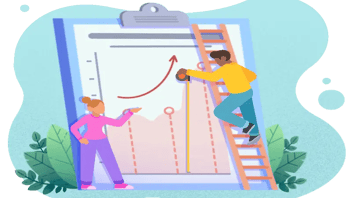Webinar: Cómo crear una presentación excelente
Con el auge del trabajo a distancia y los eventos virtuales, los seminarios web se han convertido en una forma cada vez más popular para que las empresas conecten con su audiencia y compartan información valiosa. Por ello, empresas de todo el mundo buscan formas de hacer webinars atractivos y que inviten a la reflexión, pero ¿cuál es la mejor manera de hacerlo?
Organizar un seminario web con éxito requiere algo más que pulsar el botón de "iniciar emisión". Para atraer y cautivar realmente a su audiencia, debe crear una presentación de seminario web que destaque.
.webp?width=800&height=451&name=Blog_WBM_Creating%20a%20Killer%20Webinar%20Presentation%20Tips%20and%20Best%20Practices%20(1).webp)
1. Empezar con una buena apertura
La apertura de su seminario web es fundamental para captar la atención de su audiencia y establecer el tono para el resto de la presentación. Una apertura floja o mediocre puede hacer que el público se desinterese y se pierda la oportunidad de causar impacto.
El seminario web medio tiene un índice de asistencia de aproximadamente el 40%, y sólo el 40% de esas personas ven el evento completo.
Si el comienzo de su seminario web es aburrido, no es probable que los asistentes se queden.
Por lo tanto, para empezar el seminario con fuerza, considere la posibilidad de utilizar un gancho convincente para captar la atención de la audiencia de inmediato. Puede ser una pregunta que invite a la reflexión, una estadística sorprendente o una anécdota que llame la atención. Utilice este gancho para introducir el tema de su seminario web y explicar por qué es relevante e importante para su audiencia.
He aquí algunos ejemplos:
-
¿Alguna vez se ha preguntado por qué a algunas empresas les cuesta crecer mientras que otras parecen escalar sin esfuerzo? Hoy nos sumergiremos en los secretos del éxito del crecimiento empresarial y exploraremos las estrategias que separan a las empresas con mejores resultados del resto del pelotón.
-
¿Sabía que más del 90% de las nuevas empresas fracasan en su primer año? Es una estadística desalentadora, pero no debe ser su realidad. Hoy hablaremos de los escollos más comunes que conducen al fracaso de las startups y ofreceremos estrategias prácticas para crear un negocio sostenible.
-
Cuando empecé mi propio negocio, cometí un error crítico que casi me lleva al fracaso. Me centré tanto en crear el producto perfecto que descuidé la importancia del marketing y las ventas. Hoy, compartiré las lecciones que aprendí y le mostraré cómo evitar los mismos errores que casi descarrilan mi negocio.
Otra estrategia eficaz es personalizar la apertura presentándote brevemente a ti mismo y tus antecedentes. Esto puede ayudar a establecer credibilidad y crear una buena relación con el público.
Sea cual sea la estrategia de apertura que elija, asegúrese de que sea clara, concisa y relevante para el tema de su seminario web. Evite introducciones largas o tangentes no relacionadas que puedan desviar la atención del punto principal de su presentación.
Recuerde que sólo dispone de unos segundos para captar la atención de su público, ¡haga que cuenten! Un buen comienzo puede sentar las bases para una presentación exitosa y mantener a su audiencia interesada de principio a fin.
2. Mantenga el contenido centrado y bien estructurado
A la hora de crear una presentación para un seminario web, es importante mantener el contenido centrado y bien estructurado. Esto significa tener una idea clara de lo que se quiere tratar y organizar la presentación de forma que tenga sentido para el público.
Para centrar el contenido, empiece por identificar los puntos clave que quiere tratar y póngalos por orden de prioridad en función de su importancia para el público. Recuerde que, a menudo, menos es más, y que es mejor tratar en profundidad unos pocos puntos clave que hacer una lista interminable de temas.
Una vez identificados los puntos clave, estructure la presentación de forma lógica y fácil de seguir. Considera la posibilidad de utilizar un esquema o una agenda claros que puedas consultar a lo largo de la presentación para no perder el hilo.
Al presentar cada punto, facilite suficientes detalles y contexto para que el público lo entienda con claridad. Utilice ejemplos, estudios de casos y otros materiales de apoyo para ilustrar sus puntos y hacerlos más comprensibles.
Por último, concluya la presentación con un resumen claro de las principales conclusiones y los pasos siguientes que desea que dé el público. Esto le ayudará a reforzar su mensaje y a dejar una impresión duradera en sus espectadores.
3. Utilice elementos visuales y multimedia atractivos
Una de las formas más eficaces de mejorar la presentación de su seminario web es incorporar elementos visuales y multimedia atractivos. Esto puede incluir imágenes, vídeos, infografías, tablas y gráficos, todo lo cual puede ayudar a dar vida a su mensaje y hacerlo más atractivo para su audiencia.
Las ayudas visuales ayudan a romper la monotonía de una presentación larga y mejoran la retención y el compromiso de la audiencia. Los estudios han demostrado que las personas retienen mejor la información cuando se les presenta con elementos visuales que cuando sólo se les habla.
Para utilizar los elementos visuales con eficacia, empiece por identificar los puntos clave que quiere exponer y, a continuación, busque ayudas visuales que le ayuden a reforzar su mensaje. Evite utilizar elementos visuales demasiado complejos o que distraigan la atención, ya que pueden desviar la atención del punto principal de la presentación.
Además, utilice imágenes y vídeos de alta calidad que sean relevantes para su tema y estén en consonancia con su marca. Considere la posibilidad de utilizar animaciones y otros elementos interactivos para mantener al público interesado durante toda la presentación.
Por último, asegúrese de que los elementos visuales y multimedia estén perfectamente integrados en la presentación para que no distraigan del mensaje. Recuerde que los elementos visuales deben complementar su mensaje, no desvirtuarlo. Elija una plataforma de webinar adecuada para esta integración.
4. Utilice la narración
Contar historias es una de las formas más poderosas de conectar emocionalmente con el público durante la presentación de un seminario web. Si entrelaza en su presentación historias con las que pueda identificarse y que resulten convincentes, ayudará a su audiencia a ver la relevancia e importancia de su mensaje, haciéndolo más memorable e impactante.
A la hora de contar historias, es importante elegir las que sean relevantes para el mensaje y tengan resonancia en el público. Piense en experiencias personales o anécdotas que puedan ayudar a ilustrar su punto de vista y hacerlo más cercano. Puede ser la historia de cómo su producto o servicio ayudó a un cliente o cómo superó un reto importante en su negocio.
El 32% de los asistentes a seminarios web sólo se implican cuando el anfitrión se apasiona por el tema.
Asegúrese de que sus historias tengan una estructura clara y un mensaje contundente que apoye los puntos principales de su presentación. Utilice un lenguaje vívido y detalles sensoriales para dar vida a sus historias y ayudar a su público a visualizar los escenarios que está describiendo.
5. Haz que tu presentación sea interactiva
Uno de los mayores retos de una presentación en un seminario web es mantener a la audiencia interesada y concentrada durante toda la sesión. Una forma eficaz de mantener el interés del público es incorporar elementos interactivos a la presentación. Esto incluye encuestas, cuestionarios, sesiones de preguntas y respuestas o actividades en grupo.
Los elementos interactivos ayudan a romper la monotonía de una presentación larga y fomentan la participación del público. También proporcionan información valiosa que puede ayudarle a adaptar su mensaje a las necesidades e intereses de su público.
Cuando planifique sus elementos interactivos, tenga en cuenta las necesidades y preferencias de su audiencia. Piense qué tipo de actividades o ejercicios serían más relevantes y atractivos para ellos. Por ejemplo, sesiones de lluvia de ideas en grupo o salas para debates en grupos reducidos.
Asegúrese también de que los elementos interactivos coincidan con los puntos principales de la presentación. Evite utilizar actividades o ejercicios demasiado complejos o que distraigan, ya que pueden desviar la atención de su mensaje.
6. Practique su presentación y su ritmo
La forma de realizar su presentación en un seminario web puede influir significativamente en la eficacia y el compromiso de su mensaje. Para garantizar que su presentación resulte atractiva y eficaz, es esencial que practique su presentación y su ritmo.
Un elemento clave de una buena presentación es un tono seguro y entusiasta. Cuando practique su presentación, concéntrese en hablar con claridad y con energía y entusiasmo. Practique sus discursos de apertura y cierre para asegurarse de que son impactantes y memorables.
El ritmo es importante para mantener el ímpetu y la atención del público durante toda la presentación. Haz pausas y descansos entre temas para que el público asimile el mensaje y mantenga la atención. Si se da cuenta de que habla demasiado deprisa, reduzca la velocidad y tómese su tiempo para que el público asimile el mensaje.
Otro elemento importante es el contacto visual. Mire directamente a la cámara y diríjase a su público como si hablara con él en persona.
7. Utilice datos y estadísticas
Utilizar datos y estadísticas para respaldar sus argumentos es una forma eficaz de establecer credibilidad y demostrar su experiencia en un tema determinado. Incorporar datos y estadísticas a su presentación en un seminario web puede ayudarle a generar confianza en su audiencia y a defender sus ideas de forma convincente.
Cuando utilice datos y estadísticas en su presentación, es fundamental que se asegure de que son pertinentes y precisos. Utilice fuentes fiables y atribuya claramente los datos o estadísticas que utilice.
Las ayudas visuales, como cuadros, gráficos e infografías, también pueden ayudar a que los datos sean más accesibles y atractivos para el público. Asegúrate de etiquetar tus ayudas visuales con claridad y utiliza gráficos sencillos y fáciles de entender para que tus datos sean más comprensibles.
Otra consideración importante al utilizar datos y estadísticas es emplearlos con moderación. No abrume a su audiencia con demasiados datos o información. En su lugar, utilice unos pocos datos clave para ilustrar sus puntos principales.
8. Incorpore humor y (su) personalidad 😉 .
Incorporar humor y personalidad a la presentación de su seminario web puede hacer que su mensaje sea más memorable y atractivo para su audiencia. Al inyectar un poco de desenfado y personalidad en su presentación, puede ayudar a su audiencia a conectar con usted y su mensaje a un nivel más personal.
Una forma de incorporar el humor a su presentación es a través de anécdotas o historias personales. Comparta una experiencia personal relacionada con el tema de su presentación que le ayude a ilustrar su punto de vista y a conectar con su público.
Otra forma de incorporar el humor es mediante chistes o juegos de palabras, pero utilícelos con moderación y de forma adecuada. Evite los chistes que puedan considerarse ofensivos o inapropiados, y asegúrese de que concuerdan con el tono y el mensaje de su presentación.
La personalidad también puede incorporarse a través del estilo de presentación y la forma de interactuar con el público. Sea genuino y auténtico en su presentación, y utilice el humor o la ligereza para tranquilizar al público y crear un ambiente más relajado.
9. Fomente las preguntas y los comentarios
Fomentar las preguntas y los comentarios a lo largo de la presentación del seminario web puede ser una forma eficaz de mantener a la audiencia interesada y participando activamente en la presentación. Si crea oportunidades para que el público formule preguntas o comentarios, puede ayudarles a seguir participando en la presentación.
El 92% de los asistentes desea una sesión de preguntas y respuestas en directo antes de finalizar el seminario web.
Para fomentar las preguntas y los comentarios, considere la posibilidad de reservar un tiempo para una sesión de preguntas y respuestas al final de la presentación o intercalar oportunidades para preguntas y comentarios a lo largo de la misma. Esto puede hacerse mediante encuestas, cuestionarios o funciones de chat.
También puede contribuir a generar confianza y credibilidad entre el público fomentando las preguntas y los comentarios. Al responder a sus dudas y preguntas, demostrarás que valoras su opinión y que te interesa su éxito.
Asegúrese de proporcionar instrucciones claras sobre cómo hacer preguntas o dar su opinión, y esté preparado para responder a cualquier pregunta o duda. Esto puede ayudar a mantener el ritmo de la presentación y garantizar que el público reciba la información necesaria.
10. Seguimiento de los asistentes
El seguimiento de los asistentes después de su seminario web puede ser una valiosa oportunidad para seguir construyendo relaciones y alimentando clientes potenciales. Si se pone en contacto con los asistentes después del seminario web, demostrará que valora su participación y que está interesado en su éxito.
Para realizar un seguimiento eficaz, considere la posibilidad de enviar un correo electrónico personalizado a cada uno de los asistentes agradeciéndoles su participación y proporcionándoles los recursos pertinentes o los siguientes pasos. Esto puede ayudar a reforzar el mensaje de su presentación y mantener su marca en la mente de su audiencia.
Además, considere la posibilidad de utilizar el seguimiento como una oportunidad para recopilar comentarios de los asistentes sobre su experiencia con el seminario web. Esto puede proporcionar información valiosa sobre lo que funcionó bien y lo que podría mejorarse en futuras presentaciones.
Al hacer un seguimiento de los asistentes, puede seguir ofreciéndoles valor e información a lo largo del tiempo, estableciendo aún más su experiencia y credibilidad en su campo. Esto puede ayudar a crear relaciones más sólidas y a alimentar las oportunidades de negocio.
De aburrido a interesante: Transforme su seminario web
La creación de una presentación de seminario web excelente requiere una planificación cuidadosa, atención al detalle y un profundo conocimiento de las necesidades e intereses de su audiencia. Siguiendo estos consejos y buenas prácticas, podrá crear una presentación de seminario web que atraiga a su audiencia, transmita su mensaje de forma eficaz y establezca relaciones duraderas con sus asistentes.
¿A qué espera? Salga ahí fuera y cree un seminario web que deje a su audiencia con ganas de más. Con estos consejos de expertos, seguro que conseguirá que todos hablen y vuelvan a por más.
Este contenido también está disponible traducido en:
- Alemán: Webinar-Präsentation: Überzeugend gestalten – Tipps & Best Practices
- Inglés: Creating a Killer Webinar Presentation: Tips and Best Practices
- Francés: Créer une présentation webinar percutante: Conseils et pratiques
- Italiano: Creare una presentazione webinar efficace: Consigli e pratiche
- Rumano: Prezentare webinar excelentă: Sfaturi și bune practici
- Chino: 制作精彩的网络研讨会演示文稿:技巧和最佳实践









Deja un comentario